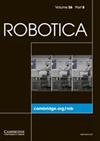Six-dimensional constraints and force feedback for robot-assisted teleoperated fracture reduction
IF 2.7
4区 计算机科学
Q3 ROBOTICS
引用次数: 0
Abstract
Robots have the capability to perform precise and minimally invasive surgeries. For the robot-assisted teleoperated fracture reduction surgery, the operating accuracy largely depends on visual reference through fluoroscopy. The operator needs to adjust several times according to computed tomography (CT) image. During the robot reduction surgery, there are large muscle forces generated by the numerous muscles surrounding the fractured segments. However, there is no effective reduction force feedback to the master robot. In this paper, in order to improve the operating accuracy of the fracture reduction with teleoperated surgery mode, six-dimensional constraints of the master robot are studied by utilizing the virtual fixture method, which can restrict the position and orientation through the force and visual guidance. The six-dimensional force sensor is used to collect information of the reduction force. For the master robot, a motor stall control method based on the current loop is adopted to provide feedback of the reduction force, which can enhance the surgeon’s sense of operational presence. To verify the effectiveness of virtual fixture and force feedback, the fracture reduction experiments are conducted on the fractured model with simulating lager muscle force. Experimental results show that the reduction errors are within acceptable ranges:机器人辅助远程操作骨折复位的六维约束和力反馈
机器人有能力进行精确的微创手术。对于机器人辅助远程操作的骨折复位手术来说,操作精度主要取决于透视的视觉参考。操作员需要根据计算机断层扫描(CT)图像进行多次调整。在机器人复位手术过程中,骨折节段周围的众多肌肉会产生很大的肌力。然而,主机器人没有有效的减张力反馈。本文利用虚拟夹具方法研究了主机器人的六维约束,通过力和视觉引导来限制位置和方向,从而提高远程手术模式下骨折复位的操作精度。六维力传感器用于采集减张力信息。对于主机器人,采用基于电流环的电机失速控制方法来提供减小力的反馈,从而增强外科医生的操作临场感。为了验证虚拟夹具和力反馈的有效性,在模拟较大肌肉力的骨折模型上进行了骨折缩小实验。实验结果表明,减小误差在可接受范围内:0.03/pm 0.73\textrm{mm}$ 、0.54/pm 0.43\textrm{mm}$ 、0.46/pm 1.05\textrm{mm}$ 、1.05/pm 1.31^{circ}$ 、1.15/pm 1.91^{circ}$ 、1.09/pm 2.61^{circ}$ 。与传统方法和其他远程操作方法相比,本文方法的骨折复位精度和手术效率均有显著提高。
本文章由计算机程序翻译,如有差异,请以英文原文为准。
求助全文
约1分钟内获得全文
求助全文
来源期刊

Robotica
工程技术-机器人学
CiteScore
4.50
自引率
22.20%
发文量
181
审稿时长
9.9 months
期刊介绍:
Robotica is a forum for the multidisciplinary subject of robotics and encourages developments, applications and research in this important field of automation and robotics with regard to industry, health, education and economic and social aspects of relevance. Coverage includes activities in hostile environments, applications in the service and manufacturing industries, biological robotics, dynamics and kinematics involved in robot design and uses, on-line robots, robot task planning, rehabilitation robotics, sensory perception, software in the widest sense, particularly in respect of programming languages and links with CAD/CAM systems, telerobotics and various other areas. In addition, interest is focused on various Artificial Intelligence topics of theoretical and practical interest.
 求助内容:
求助内容: 应助结果提醒方式:
应助结果提醒方式:


